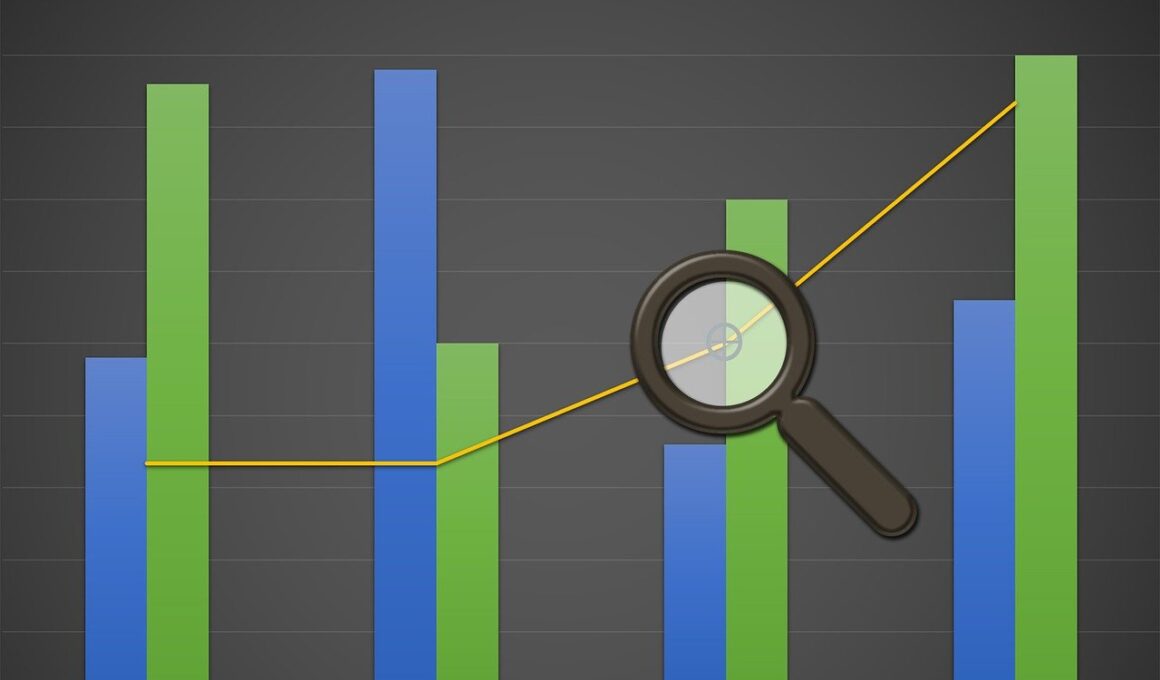Future Trends in Economic Indicators: What Businesses Should Expect
In the upcoming years, economic indicators are expected to evolve significantly, impacting businesses across various sectors. Consistently tracking these indicators, including GDP growth, inflation rates, and unemployment statistics, will be vital for strategic planning. As businesses focus on global markets, understanding regional variances in economic growth will become increasingly important. Companies must adapt to changes in consumer spending patterns that these indicators signal. The integration of technology will enhance data collection, enabling more accurate predictions of economic trends. Furthermore, businesses will benefit from diversifying their portfolios based on the insights gained from these indicators. For instance, these insights can help in identifying emerging markets. Analysts predict that firms leveraging real-time data will stay ahead of competitors, making informed decisions swiftly. Additionally, collaboration with data analytics firms will enable companies to interpret economic figures effectively. Being responsive to fluctuations in economic indicators will also help businesses mitigate risks while optimizing operations. In summary, attention to these indicators is crucial for staying competitive in a dynamic global economy.
Impact of Technology on Economic Indicators
With the continuous advancement of technology, economic indicators are becoming more readily available and actionable. The rise of data analytics and artificial intelligence will allow companies to harness insights from vast amounts of data. For example, machine learning algorithms can predict trends based on historical data, offering businesses a competitive edge. Companies can utilize this technology to monitor key economic indicators like consumer confidence and purchasing power. The ability to process data in real-time enables businesses to react swiftly to changes in the economy. Furthermore, mobile apps and online platforms offer instant access to economic data, making it easier for businesses to adjust strategies as necessary. This trend is especially crucial for small to medium-sized enterprises (SMEs) that may not have dedicated analysis teams. Hence, leveraging technology will facilitate better decision-making and resource allocation. Moreover, integrating economic indicators with internal business metrics enhances strategic goals alignment. Companies that embrace these technological advancements will likely outperform competitors that lag in adopting these tools. In conclusion, technology will play a pivotal role in shaping how businesses perceive and react to economic indicators.
As globalization continues shaping economic landscapes, businesses must pay closer attention to international economic indicators. Global trade dynamics influence local economies significantly. Hence, it’s crucial for businesses to understand foreign market indicators, such as exchange rates and trade balances. These indicators can directly affect profit margins, particularly for companies reliant on imports or exports. Being aware of international economic trends allows businesses to develop strategies that mitigate risks associated with currency fluctuations. Additionally, understanding these global metrics will enhance strategic planning regarding market entry or expansion. Companies that stay informed about global economic conditions will be better equipped to seize opportunities in emerging markets. For instance, they may choose to invest in countries showing robust economic indicators. Also, partnerships with local firms in foreign markets can help navigate these complexities effectively. Businesses should also consider the impact of geopolitical tensions on economic indicators, as stability influences investor confidence. Comprehensive knowledge of both local and international indicators becomes critical in formulating successful business strategies. Therefore, focusing on global trends is essential for businesses looking to thrive in an interconnected world.
Moreover, sustainability has become a focal point for economic indicators as businesses and governments navigate the impacts of climate change. For instance, the shift towards renewable energy sources is significantly reflected in evolving economic indicators. Companies that prioritize sustainability often report heightened consumer loyalty, which translates into better financial performance. Therefore, analyzing indicators related to environmental regulations and sustainable investments will prove critical. Businesses should actively monitor sustainability indices, as these increasingly influence consumer and investor decisions. A focus on sustainable practices could lead to enhanced brand reputation and long-term success. In addition, indicators measuring carbon emissions and resource consumption are crucial for companies assessing their environmental impact. Meeting sustainability benchmarks may not only comply with regulations but attract investment from socially responsible investors. As consumers become more environmentally conscious, economic indicators reflecting sustainability will gain further significance. Consequently, integrating these considerations into the business model can enrich strategic forecasts. Sustainable growth will determine competitive advantage, making environmental indicators a vital part of business strategy. Therefore, staying aware of sustainability trends will be essential for current and future business operations.
Additionally, demographic shifts will continue to influence economic indicators in the coming years. As populations age, businesses should recognize changes in consumer behavior and spending patterns. For instance, an older population may lead to increased demand for healthcare products and services. Insights gained from demographic data can guide businesses in tailoring their offerings. Understanding the implications of these shifts on different sectors is critical. Moreover, demographic changes impact labor markets as companies seek skilled labor amidst evolving workforce expectations. Economic indicators reflecting employment rates among various age groups will provide vital insights for workforce planning. Businesses need to adjust their recruitment strategies accordingly to attract diverse talent pools. Therefore, they must pay attention to indicators that signal changing workforce demographics. Furthermore, geographic shifts in population can highlight opportunities for expansion in underserved markets. Understanding regional demographic trends will allow businesses to develop location-specific strategies. In summary, monitoring demographic trends will enhance product development and marketing strategies effectively, capitalizing on emerging opportunities that arise from societal changes.
The incorporation of health indicators into economic forecasting is also on the rise. The COVID-19 pandemic demonstrated that public health directly impacts economic performance. Therefore, companies must now consider health-related indicators like vaccination rates and overall population health when making forecasts. A healthy population supports a robust workforce, which in turn boosts productivity and economic growth. Analyzing such health indicators can guide businesses in understanding labor capacity and potential market expansions. Additionally, companies may need to adapt their health policies as part of their strategic planning. For example, investing in employee health initiatives can improve productivity and reduce healthcare costs. More businesses will charter a proactive approach to health-related economic indicators, aligning workforce health with overall economic health. Furthermore, collaborating with public health organizations will enable businesses to understand and respond to changes more rapidly. As economies stabilize post-pandemic, companies must remain vigilant about health indicators and their implications for economic growth. Prioritizing health and wellbeing will lead not only to better financial performance but also to improved reputation and stakeholder trust.
Lastly, the emphasis on consumer sentiment and confidence indices will shape future economic indicators. These indices provide insights into public perceptions regarding the economy and overall financial situation. Businesses should track consumer sentiment as it directly impacts spending behavior. A rising confidence index generally correlates with increased consumer spending, indicating an economic recovery. Conversely, declining sentiment can signal reduced spending and demand. Understanding these dynamics is essential for inventory management and pricing strategies. Moreover, businesses should explore ways to enhance consumer confidence through targeted marketing campaigns and community engagement. By contributing positively to communities, companies can foster loyalty and consumer trust. Additionally, thorough analysis of sentiment data allows businesses to anticipate market shifts and strategize accordingly. Investing in research to gauge consumer perceptions will pay dividends in the long run. Engaging with consumers will provide insights that influence product development and customer service. Consequently, companies can align with customer expectations effectively. Prioritizing consumer sentiment as one of the key economic indicators will enable businesses to navigate future market challenges with confidence.
This is another paragraph with exactly 190 words…


